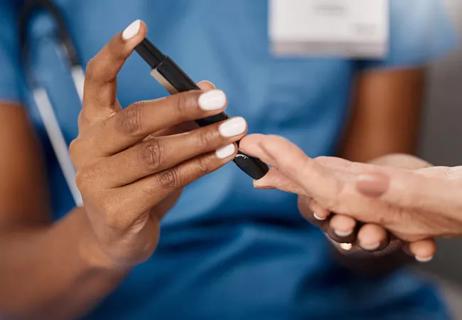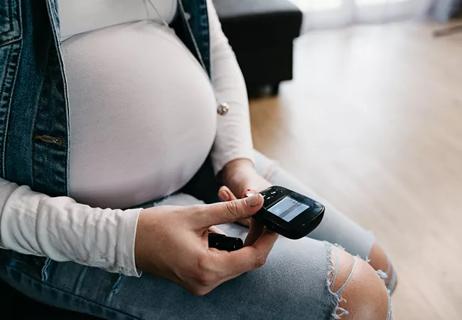Spinal cord stimulation can help those who are optimized for success

Spinal cord stimulation (SCS), a long-established treatment for back pain, also is bringing relief to some patients suffering the numbness, burning and tingling of painful diabetic neuropathy (PDN). Increasing clinician awareness about the latest research may open a new avenue for those who treat patients with significant or even debilitating PDN, says Cleveland Clinic pain management specialist Sherif Constandi, MD.
Advertisement
Cleveland Clinic is a non-profit academic medical center. Advertising on our site helps support our mission. We do not endorse non-Cleveland Clinic products or services. Policy
“Diabetic neuropathy is very common condition, and it compromises patients’ quality of life – their ability to walk, to stand, and sometimes their ability to sleep well,” says Dr. Costandi. “Treatment begins with controlling blood sugar and making modifications to diet and exercise. After that, we try nerve pain medications like pregabalin and gabapentin.”
In the past, there has been nothing left to offer patients who weren’t helped by, or who couldn’t tolerate, oral medications. “Many end up being in refractory pain, and some become disabled,” says Dr. Costandi. “Then they can enter a chronic pain cycle. Diminished mobility leads to less functionality which leads to deconditioning and then more pain.”
In 2021, the U.S. Food and Drug Administration approved 10-kHz spinal cord stimulation for patients for whom conventional medical management (CMM) has failed or is insufficient. Cleveland Clinic participated in the multicenter study leading up to that approval, in which high-frequency spinal cord stimulation used along with CMM was compared to CMM alone.
“There was a dramatic difference,” says Dr. Costandi. “Seventy-nine percent of those who received the stimulatory device reported improvement, compared to 5% reporting improvement with conventional management alone.”
“The SCS patients reported improvement in their quality of life,” he adds. “Patients reported reduced numbness, burning, tingling and cold sensations. In addition, there was also evidence of improvement on neurological examination in 62 % in the stimulation group compared to 3% in the conventional arm alone. We could hypothesize there is some nerve growth.”
Advertisement
The takeaway, he says, is that SCS should be solemnly considered for patients with PDN.
“It’s one tool,” says Dr. Costandi. “We must use it right and use it for the right patients. It is not for everyone. Just like any other line of treatment, it has pros and cons to consider whenever we make our assessment.”
Among the factors to consider when assessing whether SCS is right for a given patient are glucose control, patient motivation, and a decrease in the central nervous component of pain.
“Patients need to have reasonable control over their blood sugar,” says Dr. Costandi. (Study participants were required to have a hemoglobin A1c of 10% or less.)
“Whenever we implant devices in patients with high HbA1c scores, those patients tend to have more infections,” he says. “So we work with patients first, improve their blood sugar control, and then once we get a good number or indicator, we can consider doing the implants.”
Because the goals of treatment for PDN include improving function and reversing any deconditioning, a person being considered for SCS must be motivated to be more active, says Dr. Costandi. “It is wasteful to take the device and then stay home. Patients need to be looking to do more and to use their device.”
Patients whose pain has become centralized must have those symptoms addressed before being considered for SCS. “When this happens and we implement our device, then the patient will actually respond well,” he says.
Those with central pain syndrome are referred to pain psychologists and behavioral therapists to help them minimize that component. “As they learn how to cope better with pain, they will respond much better to any kind of treatment, not just neuromodulation.”
Advertisement
The FDA requires anyone being considered for SCS to undergo psychiatric evaluation to ensure there are no underlying disorders that are not being managed or properly treated.
“There’s no problem implanting the devices in patients who are suffering from depression or any other psychiatric disorders as long as they are controlled,” says Dr. Costandi. “It’s a tool for everyone, but the caveat is that conditions need to be controlled and properly monitored so that the patient will respond to the therapy.”
Dr. Costandi’s hope is that more primary care physicians and endocrine specialists will consider SCS for PDN when it is appropriate.
“The multicentered study showed significant improvements in pain scores and that patients are responding well. It is a promising tool that physicians should include in their algorithm of treatments.”
Advertisement
Advertisement

Association revises criteria for the diagnosis and resolution of severe conditions

Less than 50% of patients with diabetes get appropriate ophthalmic screening through primary care referrals

Familiarity will enhance its accessibility for patients with diabetes

New study counters earlier findings linking drugs with eye disease

Study highlights the value of quantitative ultra-widefield angiography

Longevity in healthcare, personal experiences may provide caregivers with false sense of confidence

Maternal-fetal medicine specialists, endocrinologists and educators team up

Cleveland Clinic’s Endocrinology & Metabolism Institute is working to offer novel opportunities and therapies for diabetes and kidney disease